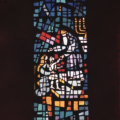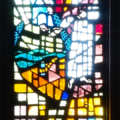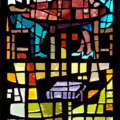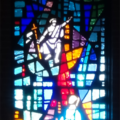Sanctuary Window 3—The Leader—A
Welcome back to Windows Wednesday. Today, we are examining the top, “God, the Father” portion of Sanctuary Window 3, The Leader. This window as a whole shows the quality of leadership displayed in the Old Testament, by Jesus in the New Testament, and inspired by the Holy Spirit in the world today. Leadership in the Old Testament has no better example than Moses.
Moses was God’s chosen leader of the Israelite people from slavery in Egypt, through the desert, and ultimately to the promised land. Since the time of Joseph (of the coat of many colors), the Israelites had lived in Egypt, and the pharaoh’s treatment of them become steadily worse. At the peak of their misfortune, God came to Moses and recruited him to convince the pharaoh to free the Hebrew people from their slavery and allow them to leave Egypt. In this portion of the window, we see several iconic examples of this period in Biblical history.
Above the figure of Moses, we see the two tablets of the 10 Commandments, given to him on Mt. Sinai to deliver to the Hebrew people. To the right, we see the bush that burned, but was not consumed; and below him is the staff that transformed into a serpent, meant to convince the pharaoh of the power of God. Click or scroll over the image below to see the artist’s original design for the window.
There the angel of the Lord appeared to him in a flame of fire out of a bush; he looked, and the bush was blazing, yet it was not consumed.Then Moses said, “I must turn aside and look at this great sight, and see why the bush is not burned up.” When the Lord saw that he had turned aside to see, God called to him out of the bush, “Moses, Moses!” And he said, “Here I am.” Then he said, “Come no closer! Remove the sandals from your feet, for the place on which you are standing is holy ground.”He said further, “I am the God of your father, the God of Abraham, the God of Isaac, and the God of Jacob.” And Moses hid his face, for he was afraid to look at God.
[virtual_slide_box id=”17″]Then the Lord said, “I have observed the misery of my people who are in Egypt; I have heard their cry on account of their taskmasters. Indeed, I know their sufferings, and I have come down to deliver them from the Egyptians, and to bring them up out of that land to a good and broad land, a land flowing with milk and honey, to the country of the Canaanites, the Hittites, the Amorites, the Perizzites, the Hivites, and the Jebusites. The cry of the Israelites has now come to me; I have also seen how the Egyptians oppress them. So come, I will send you to Pharaoh to bring my people, the Israelites, out of Egypt.”
But Moses said to God, “Who am I that I should go to Pharaoh, and bring the Israelites out of Egypt?” He said, “I will be with you; and this shall be the sign for you that it is I who sent you: when you have brought the people out of Egypt, you shall worship God on this mountain.” Exodus 3:2–12




